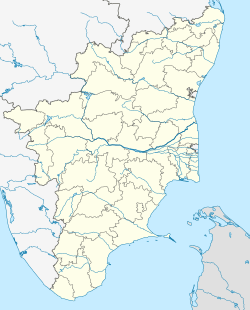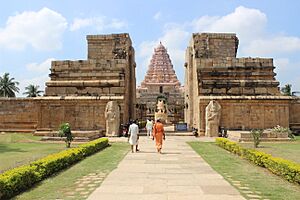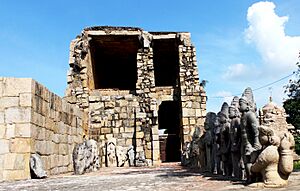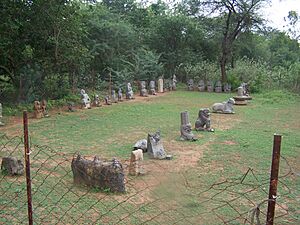Gangaikonda Cholapuram facts for kids
Quick facts for kids
Gaṅgaikoṇḍa Chōḻapuram
|
|
|---|---|
|
Town
|
|
| Gaṅgaikoṇḍa Chōḻapuram | |
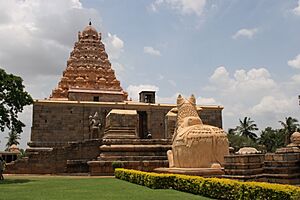
The Shiva temple in Gangaikonda Cholapuram
|
|
| Country | |
| State | Tamil Nadu |
| Region | Chola Nadu |
| Languages | |
| • Official | Tamil |
| Time zone | UTC+5:30 (IST) |
Gaṅgaikoṇḍa Chōḻapuram is a village in Tamil Nadu, India. It is near Jayankondam in the Ariyalur district. Around the year 1025, it became the capital of the powerful Chola dynasty. This city remained the Chola capital for about 250 years.
Today, Gaṅgaikoṇḍa Chōḻapuram is known as a heritage town. Its most famous building is the great Arulmigu Peruvudaiyar Temple. This temple is almost as grand as the one in Thanjavur. It is even better in terms of its amazing sculptures. UNESCO has named this temple a World Heritage Site.
Contents
History of the Chola Capital
The city of Gaṅgaikoṇḍa Chōḻapuram was founded by Rajendra Chola I. He built it to celebrate his big victory over the Pala Dynasty. The name of the city means "the city of the Cholas who brought the Ganga (river water)". It reminds everyone of the time when Rajendra I brought water from the Ganges River here.
The Chola Empire was very large. It covered all of southern India up to the Tungabhadra river. Rajendra I built this new capital for better control and protection. Today, it is a small village. Only the huge Shiva Temple reminds us of its important past.
City Walls and Defenses
The ancient city likely had two sets of walls for protection. There was an inner wall and a wider outer wall. You can still see parts of the outer wall as a raised area around where the palace once stood.
Digs show that the outer wall was made of burnt bricks. It was about six to eight feet wide. It had two walls with sand filled in between them. The bricks were large and well-made. Archaeologists are still exploring nearby areas. They believe there might have been workshops for making weapons.
The Great Temple's Story
The main temple in Gaṅgaikoṇḍa Chōḻapuram was finished in 1035 CE. Rajendra I built it after a successful military campaign. Chola records say he traveled across India. He conquered lands in Karnataka, Andhra Pradesh, Odisha, and Bengal. After his victories, he asked the defeated kings to send pots of Ganges River water. This water was poured into the temple's well.
Rajendra I then took the name "Gangaikonda Cholan." This means "the one who conquered the Ganges." He moved the capital from Thanjavur to this new city. It remained the capital for the next 250 years. Rajendra I planned the entire city. He built many temples, including ones for Ayyappan and Vishnu. Sadly, most of these temples were destroyed later. Only the Brihadishvara temple remains.
Why the City Was Destroyed
It is not fully clear why the city was destroyed. Some historians think the Pandyas might have ruined it. They defeated the Cholas in the late 1200s. This could have been revenge for earlier defeats. However, it is strange that the main temple was saved. Also, many later kings gave gifts to this temple.
Another idea is that the city was attacked by armies from the Delhi Sultanate. This happened in the 1300s. Later, the Vijayanagara Empire took control. They repaired and restored many temples, including this one. The temple was recently re-opened in 2017 after more repairs.
Arts and Architecture
The Chola rulers loved art and building. They built the amazing Gangaikondacholisvara temple. This temple has sculptures that are truly special. The bronze statues of Bhogasakti and Subrahmanya are famous Chola artworks. The shiva lingam inside is carved from a single stone.
Rajaraja I, Rajendra's father, built the famous Brihadishvara temple in Thanjavur. It is about 50 km from Gaṅgaikoṇḍa Chōḻapuram. This temple was built between 1003 and 1010 CE. It is dedicated to Shiva. A huge statue of Nandi, Shiva's sacred bull, stands in its courtyard.
Chola bronze statues are known worldwide. They are famous for their beauty and lifelike look. Many beautiful figures of Nataraja, the dancing Shiva, were made during this time.
Royal Palace Details
The royal palace was also built with burnt bricks. The ceilings were covered with small, flat tiles. These were set in fine lime mortar. The pillars were likely made of polished wood. They stood on granite bases. Some of these stone bases can still be seen today. Iron nails and clamps have also been found at the palace site. There is even a tunnel that connects the palace to the temple.
During the rule of Virarajendra Chola, Rajendra's son, the palace was called Chola-Keralan Thirumaligai. This name came from one of Rajendra I's titles. Records show parts of the palace like the ground floor (adibhumi). They also mention a special seat called Mavali vanadhirajan. This suggests the palace had many floors. It is likely there were several royal buildings, each with its own name.
City Roads and Gates
Old writings tell us the names of some roads and streets. The main entryways were called Thiruvasal (the eastern gate) and Vembugudi gate (the south gate). There were also highways named after Rajaraja and Rajendra. These were called Rajarajan Peruvali and Rajendran Peruvali.
Other streets mentioned include the "ten streets" (Pattu teru). There was also the "gateway lane" (Thiruvasal Narasam). Another highway was called "Kulaiyanai pona Peruvali." This means "the highway through which a short elephant passed by."
City Layout and Water
The city had a special channel called the Madhurantaka Vadavaru. It is now called the Vadavaru. This channel ran about six kilometers east of the old capital. It was named after one of Rajendra I's titles. This channel brought water to a large area around the capital for farming. Another irrigation channel was called Anaivettuvan. This name means "irrigation by labor or engineer."
Both wet and dry lands were inside the fort walls. These were used for farming and other things. The locations of the remaining temples tell us about the city's design. The palace was in the center. The great Shiva temple was to the northeast. This fits old building rules (Vastu). The Vishnu temple was likely in the west.
Many small tanks, ponds, and wells provided drinking water. These are mentioned in old records.
See also
- Suryadeva Yajvan, a scholar from Gangaikonda Cholapuram


